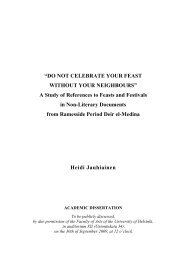BIA
bia51
bia51
You also want an ePaper? Increase the reach of your titles
YUMPU automatically turns print PDFs into web optimized ePapers that Google loves.
MARS 2015<br />
scenes depicting their owners with the god<br />
Amun, and during hunting and cultivation<br />
activities. Other scenes show the tombs’ owners<br />
and their wives in front of an offering table.<br />
Dimanche 22 mars 2015<br />
The first tomb belongs to a guard of the<br />
temples of the god Amun named Amenhotep<br />
Rabiu and his wife Satamen. The second<br />
belongs to a noble called Samut and his wife<br />
Takhaeet.<br />
“The incredibly beautiful works displayed in<br />
the tombs demonstrate once again the majesty<br />
of the ancient Egyptians and their unequalled<br />
skill in creating gorgeous murals depicting<br />
scenes from Egyptian life,” said Minister of<br />
Antiquities Mamdûh al-Damâtî.<br />
Sultân ‘Îd, director of Upper Egyptian<br />
Antiquities at the ministry, said that the tombs<br />
were looted in antiquity, as their funerary<br />
collections and sarcophagi are missing. Some<br />
parts of the decoration and hieroglyphic texts<br />
were also erased, as well as the name of the<br />
god Amun, indicating that the tombs could<br />
have been damaged during the religious<br />
revolution led by the monotheistic king<br />
Akhenaten, who united all the ancient Egyptian<br />
gods into a single god, known as Aten.<br />
Amenhotep’s tomb is T-shaped with two<br />
large halls and an unfinished small niche at<br />
the rear of the tomb. An entrance leading to a<br />
side room with a shaft in the middle is at the<br />
tomb’s southern side. “A shaft of this type<br />
could lead to the burial chamber,” al-Damâtî<br />
said.<br />
The second tomb is composed of a<br />
rectangular hall with a shaft, now filled with<br />
sand, in the middle. Two doors opening to the<br />
first tomb were also found. Both tombs will<br />
now be restored. (Nevine El-Aref, “Luxor tombs<br />
found”, Al-Ahram Weekly, March 19, 2015. Voir<br />
également Dînâ ‘Abd al-‘Alîm, « Le ministre de<br />
l’Archéologie annonce la découverte d’une<br />
nouvelle tombe à Louqsor », al-Yawm al-Sâbi‘,<br />
10 mars).<br />
- -<br />
After five years of restoration the first and<br />
fifth Sphinxes Avenues, which once connected<br />
both Karnak and Luxor temples in ancient<br />
times, are to be opened tomorrow night for the<br />
first time. Minister of Antiquities Mamdûh al-<br />
Damâtî is to cut the ribbon to open a new<br />
tourist destination in the town. He told Ahram<br />
Online that the restoration of the Sphinx<br />
Avenue and installing new lightening and<br />
security systems in Luxor temple came within<br />
the framework of the ministry’s efforts to<br />
protect the country’s ancient shrine.<br />
al-Damâtî explained that the development of<br />
Luxor’s temple lighting and security systems is<br />
a part of a Spanish grant of 150 million euros<br />
used for the implementation of a scheme to<br />
protect every archaeological site in Theban so<br />
they can be visited at night and be wellprotected.<br />
He went on to say that the new<br />
lighting system is made according to the latest<br />
technology, which guarantees the preservation<br />
of the temple walls and engravings.<br />
For his part Major General Muhammad al-<br />
Shaykha, head of the Projects Department at<br />
the ministry of antiquities, said that the security<br />
system installed in the temple includes of an<br />
electronic curtain stretched around the temple,<br />
along with monitoring cameras connected to a<br />
TV circuit. He told Ahram Online that the<br />
restoration of the first and fifth sections of the<br />
Sphinxes Avenue represents 37 per cent of the<br />
whole path. It was carried out in collaboration<br />
with the National Service Projects with a budget<br />
of LE66.5 million.<br />
He went on to say that the restoration work<br />
of the first section, which stretches from the<br />
Luxor temple to 350 metres long, includes the<br />
removal of all encroachment as well as the<br />
consolidation of the avenue’s eastern wall and<br />
<strong>BIA</strong> LI — Janvier/Juin 2015 65



